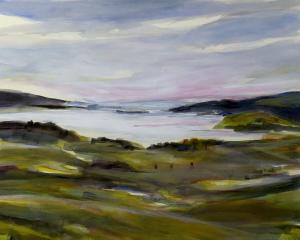"Five new works, five old works", Martin Thompson (Brett McDowell Gallery)
This symbiosis is rarely seen to as great an extent as in the obsessive work of Martin Thompson.
Thompson's grids are based on pure mathematics, so much so that the artist himself hesitates before describing them as art. Yet their aesthetic sensibilities are such that they cannot be thought of in any other way.
Painstakingly created from indelible marker and graph paper, the works have a structure supplied purely from a mathematical basis.
The rectilinear formality of the pieces is built up into hypnotically recursive patterns which are ostensibly digital, despite their manual creation. The simple yes/no, coloured/white squares are true handmade pixels.
The complex flow of the work across the paper creates mirror areas of dark and light that - while falling into the catchall category of outsider art - has antecedents in the rigid minimalism of Mondrian and Malevich and the op art of Riley.
Above all, it is the sheer beauty of the patterns which stands out, though the viewer cannot help but marvel at the mind-bending dedication that has been required to produce these images.
"Debut", Anneloes Douglas (Mint Gallery)
The structure of a fern leaf reflects a fractal geometry, and all art cannot but reflect nature either directly or indirectly.
Photography, too, links science and art, both in its technology and in its purity of image.
This image forms the basis for the construction of the finished artwork, either as a direct realistic representation relying on the photographer's skill to recognise, organise, and capture, or through their manipulative skills to create and embellish from a realistic starting point.
Anneloes Douglas, in her exhibition "Debut", proves herself more than worthy on both these photographic counts.
Her series of images captures the essence of her natural subjects and then builds upon this with the soft, ambiguous manipulations, both of focus and of colour.
Shape, for example, catches the ephemeral straining weightlessness of a soap bubble, and Expose, with its hallucinogenic red daffodils, is alive with the swirl of a dream wind.
In Forge, colour is leached away to leave iron-hard fern, the strength of which is emphasised by the subtle placement of a delicate daisy, whereas the marvellous Paint swathes beech forest in a softly burning palette of scarlet and amber.
"Seeking sanctuary", Clare Reilly (Gallery on Blueskin)
Her images, which focus upon native birds in clear, crisp, coastal surroundings, have what writer Dr Gail Ross, in the artist's earlier catalogue notes, well describes as a fresco-like air, giving the paintings the feel of religious art praising the glory of nature itself.
The works have a simple, clean line, and a tranquil majesty is imparted through the soft, glowing colours of the artist's palette.
The paintings are oils, yet the gentle luminescence of the works suggests otherwise, with soft smoothly-graded areas which could as easily be gouache or even watercolour.
Colour is effectively used, allowing a solid focus on the tui and kereru which are at the heart of the compositions.
The deeper tones of the birds' plumage is reflected in key features of the backgrounds, and the fine details of these surroundings, notably the blooms of harakeke and echium, are masterfully yet simply recreated.
As if any further evidence was needed of the artist's empathy with her subject, she has been heavily involved in conservation work aimed at protecting tui on Banks Peninsula, the landscape of which forms the zen-like backdrop of many of her works.











